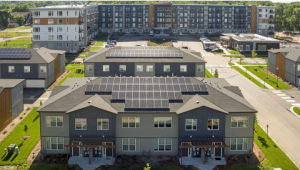Brendan Beecham is an undergraduate Computer Science major at Michigan Tech. He can be reached at blbeecha@mtu.edu.
Understanding the Need
In the present-day variable economy, split incentives could be used as a method of lowering the overall energy bill for a renting tenant. By sharing the cost of energy between the landlord and the tenant, the difficulty that arises with paying for high-cost energy services is mitigated. This in turn allows the renter to use the saved money to pay for other goods and services and inspires sustainable living through spending less on utilities.
Source: nucherenonagel.com
The power of utilizing split incentives comes from the motivation from the landlord and tenant to be energy efficient. If the landlord accepts one lump sum fee from the tenant as a substitute for the tenant paying the utility themselves, they have much less reason to be mindful of how much energy they use. On the other hand, if a tenant pays their own electric bill every month themselves, the landlord might not see it as worth their money to install energy efficient lights and appliances. This is where split incentives shine.
When each party in the landlord/tenant relationship is responsible for their own half of the electric bill, there is much more pressure to be energy efficient. This is present in many more cases than just rental housing, but for simplicity I will focus on just the landlord/tenant relationship instead of hotels or big businesses.
Affordability For Those That Need It
Split incentives are especially important when discussing energy poverty. This is where lower income renters will end up allocating significantly more of their household income to energy bills than other renters. In this case, split incentives can cripple the financial stability of that renter and affect their quality of life. Additionally, this renter’s landlord will most likely be affected by the instability of the renter’s financial situation, which could lead to possible missed rent payments and cause for both parties to be in an unstable financial relationship. Implementing split incentives effectively can help both the renter and the landlord.
Energy poverty is an issue that arises from the infrastructure and behavior of the energy industry as it stands today. This is a huge issue. Until people are able to afford the energy that they need to take part in society, the thought of living efficiently is much less a choice for some than it is a requirement. There is hope, however, as the idea of split incentives is a versatile one and can help to push forward renewable energy technology.
Source: thebalance.com
Creating A Better Transition For Renewable Energy
Split incentives could be managed in ways that create energy poverty solutions, but they could also be helpful in mitigating the cost of installing renewable energy solutions like solar panels. Where many cite the initial sunk cost of installing solar panels as the number one reason for never transitioning to using renewable energy solutions, a program that effectively splits incentives could mean a lessened financial impact on each one of the parties involved, the renter and the landlord. While no tenant wants to pay for their landlord to install solar panels out of their own pockets, a cooperative action as well as the promise of lower energy costs in the future could cast a much more appealing light on the transition. In fact, this is not unlike the benefits that come from a government incentive program, one that gives tax breaks to parties who install renewables or who have a portion of their power grid being powered by renewables.
Sharing the Cost to Save Energy
Split incentives may mean that landlords have no reason to invest in energy efficiency or renewable energy, because they don’t see the benefits of lower utility bills themselves. By acknowledging and effectively managing split incentives, the solutions for reducing energy poverty and the transition to renewable energy can be streamlined. Like with most improvements to infrastructure systems, it is the programs that are put in place to reduce sunk costs and reduce risk on one party that will push forward for the most change. No landlord will front the cost of installing solar panels if they know there is no incentive to do so. In most private rental situations, there will need to be a push to get an incentive.
Source: energynews.us
The cost of renewable energy installation makes it a very unrealistic option for most tenants, even those in long term rentals. Even with the price of solar panels dropping as the market expands, for many tenants, the cost of installations are still too high, and the split incentive of renting (when they might not directly benefit from the reduction in utility expenses) is a huge barrier. While renting is an increasing trend in the housing market, tenants won’t want to put money into rental housing, since they don’t own it and won’t see the benefits from the housing value. Most renters are less financially well off that their landlords, so spending their income to install solar panels for the benefit of the landlord is not likely.
Conclusion
Split incentives can be managed in ways that have the potential to improve quite a few factors that all relate to energy and the way it’s used in rental housing. Dividing the costs between the landlord and the tenant could provide a stronger reason to be more energy efficient for both parties. Most importantly, incorporating sustainability into the way we live is quite a daunting task, especially if money is an issue. So to share the burden with others is possibly the biggest leap to see the biggest benefits. Whether it is minimizing the energy footprint that we are leaving, or attempting to save money to be able to afford the everyday essentials in life, managing or leveraging split incentives to provide maximum benefits and incentives to both landlords and tenants is a smart first step.



